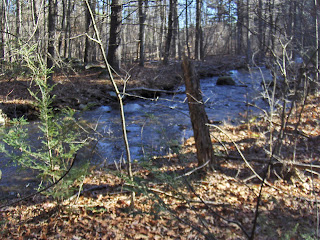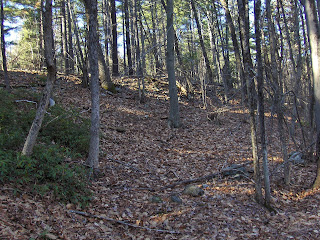Walking north along a well defined path, I notice a lot of piled rock up on the left:
Is it natural or man made? I decided pretty quickly that it was man made:
This is a large berm made of cobbles. I notice a chunk of quartz, left of center (the observant reader will also notice a small enclosure between the camera and the quartz):
Bear with me....I want to point out that the "mound" continues to the right of this picture. I am standing in a hollow with more of the rock pile behind me. It is hard to see because of the bushes but here is a shot from the end of the mound:
This part of the mound has its own chunk of quartz and, in fact the overall shape is this:
The opening faces the brook, seen below:
The hollow, on the left edge of this picture, might also be a ramp down to the brook, but I ignore that interpretation, and assume this is simply the hollow of a different shaped burial mound. Hard to get a picture of the whole thing. From one end:
Goodbye from below. You can still see one of the chunks of quartz:
This is from East Wachusett Brook in Princeton MA, around where the small blue outline is on this map:
This is the Stillwater River watershed. It is the only example of a "long mound with hollow" from south of Rt 2. As I look at the map, the Stillwater River flows south into the Wachusett Reservoir in Clinton, and then into the Nashua. So actually this 'long mound with hollow' is, like all the other examples, a feature of the Nashua and Souhegan watersheds.


















































